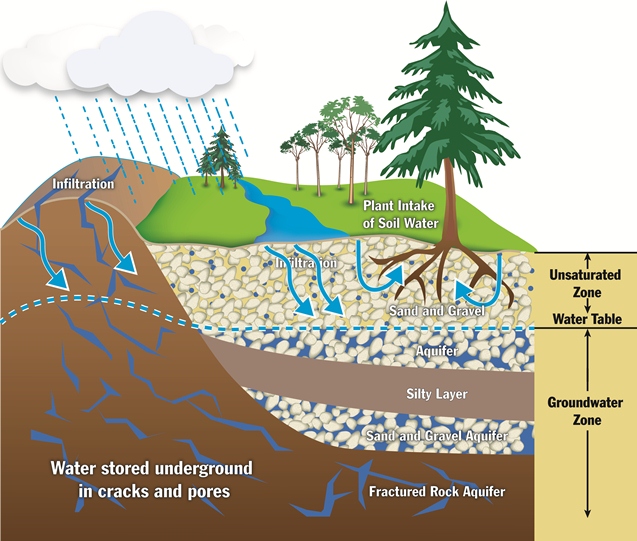A tool to replenish aquifers and increase underground water storage
Why water storage?
A reliable water supply is essential for economic, environmental, and public health, but natural water supplies vary with the seasons and between years. Water storage, whether in reservoir lakes or underground, helps to ensure that water is available even during droughts. Underground water storage is an attractive alternative to lakes in some regions because it requires very little land, does not lose water to evaporation, and can use soil and rocks as a natural filter to improve water quality.
What is managed aquifer recharge?
Aquifers are underground rock formations or sedimentary deposits porous enough to hold water. Most aquifers are naturally recharged by rainfall or other surface water that infiltrates into the ground. However, in regions where groundwater use is greater than natural recharge rates, aquifers will be depleted over time. Managed aquifer recharge (MAR), also known as water banking, consists of water management methods that recharge an aquifer using either surface or underground recharge techniques. The stored water is available for use in dry years when surface water supplies may be low.
Groundwater, the water stored underground in cracks and pores, comes from surface water (like rivers or rain) that trickles into the ground. It can also be injected into the ground using wells (not shown). Image Credit: Govt. of Newfoundland and Labrador
How does managed aquifer recharge work?
The two main approaches used to recharge aquifers are surface infiltration and deep injection.1 Surface infiltration can enhance natural aquifer recharge in several ways:
- Creating artificial streams and ponds (“spreading grounds”) in fast-draining soil
- Creating local catchment systems for rainwater and stormwater
- Diverting water to naturally infiltrating river channels during low-flow seasons
Deep injection methods put excess water directly into the aquifer using wells.
Where does the water for recharge come from?
Finding water for MAR is not always easy and depends on the local water cycle and competing uses. Existing projects rely mainly on river water, stormwater, and treated wastewater.1 Treated wastewater typically provides the steadiest supply and the least competition from other water users. River water is generally only available for aquifer recharge during wetter periods. Stormwater, despite its sporadic and seasonal availability, has become a popular source of water for aquifer recharge because stormwater MAR projects decrease flooding and capture water that is otherwise lost as runoff. In practice, many existing MAR projects rely on a combination of these water sources.
Effects on Water Quality
MAR can have both positive and negative effects on groundwater quality. This depends on the water itself, the MAR technique being used, and the interactions between the recharged water and the aquifer materials.2 The three most common water sources for aquifer recharge vary in quality:2
- River water: usually high quality due to national surface water quality guidelines
- Treated wastewater: high quality from modern treatment plants
- Stormwater: variable quality, especially in urban areas
Deep injection methods typically require more careful attention to water quality than surface recharge methods because the water is not naturally filtered by soil and rock above the aquifer.1 Many projects therefore use stormwater for surface recharge only, or they treat the water before injecting it underground. Surface recharge methods can use lower-quality water because the natural filter of soil and rock removes pollutants from the water before it reaches the aquifer,1 although not all types of pollutants can be removed in this way. Water quality risks are assessed and reduced using groundwater modeling and monitoring.
Did you know?
There are over 1,200 managed aquifer recharge projects around the world. The International Groundwater Resources Assessment Center provides a portal for global MAR information at https://www.un-igrac.org/ggis/mar-portal.
Aquifer suitability for MAR
Water storage is only possible in “closed” or “semi-closed” aquifers, in which the water does not flow from the injection site into deeper, inaccessible aquifers.3 Aquifers can also be “confined” (underneath an impervious layer that does not allow water to seep in from the surface) or “unconfined”. Deep injection methods are necessary for confined aquifers and in locations where there is little suitable land available for surface recharge, whereas surface recharge methods are especially suitable for “water table” aquifers just below the Earth’s surface.
Other uses of MAR
- Improving the quality of stormwater or treated wastewater
- Preventing land subsidence in areas of high groundwater extraction
- Preventing the intrusion of seawater from the oceans into coastal aquifers
- Making water available for sale, lease, or exchange with other water users for regional water supply sustainability
More Resources
Prospects for Managed Underground Storage of Recoverable Water, National Research Council
Management of Aquifer Recharge and Subsurface Storage, Netherlands National Committee of the International Association of Hydrogeologists
Managed Aquifer Recharge: An Overview of Issues and Options, Casanova, J, Devau N, and Pettenati M (Book Chapter)
MAR Portal, International Groundwater Resources Assessment Centre
Managed Aquifer Recharge - A Water Supply Management Tool, National Groundwater Association
Aquifer Storage Recovery - A Guide to Groundwater Recharge Through Wells, Pyne R D (Book)
Managed Aquifer Recharge in California, American Geosciences Institute
References
1 Managed Aquifer Recharge: An Overview of Issues and Options, Casanova J, Devau N, and Pettenati M (Book Chapter)
2 Prospects for Managed Underground Storage of Recoverable Water, National Research Council
3 Management of Aquifer Recharge and Subsurface Storage, Netherlands National Committee of the International Association of Hydrogeologists

This work is licensed under a Creative Commons Attribution-NonCommercial-NoDerivatives 4.0 International License.
You are free to share or distribute this material for non-commercial purposes as long as it retains this licensing information, and attribution is given to the American Geosciences Institute.

